Page 281
Writing Poems
Poems are different from other kinds of writing. They have a special shape and sound. If you read enough poetry, you’ll get better and better at understanding—and writing—poems. You’ll even make friends with some of them. Here’s how:
- Read the poem several times; listen to what it says.
- Read the poem aloud; listen to how it sounds.
- Read it with feeling to friends or classmates.
- Talk or write about the poem.
- Copy the poem in a special notebook.
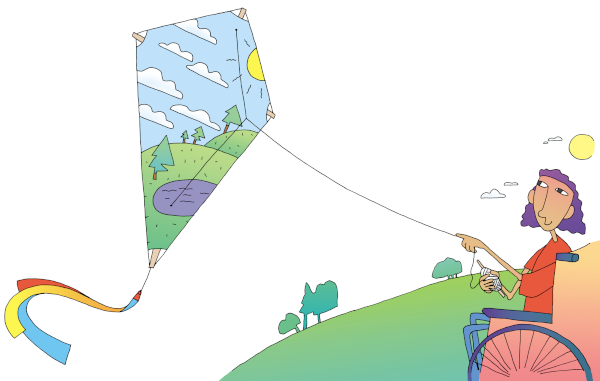
Kite
Such simple things—
paper, stick, string,
tugging finger, tugging wind—
give life to complex things—
flight, fancy, freedom.
Jigging above
the jealous earth
the paper child
capers and cries,
“Look at me, Mom!”
—Theo Reymund
What’s Ahead
WE 282
Page 282
What Makes Poetry Special?
Poetry is different from prose (the regular writing you do). Here are some things that make poetry special.
1. Poetry looks different.
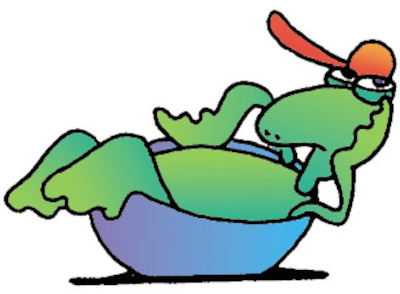
It’s easy to recognize poems. They are written in lines and stanzas (groups of lines). Some poems are short enough to fit on the inside of greeting cards, and some poems go on for many pages. Here is a one-stanza, five-line poem in limerick form.
Otis for President
I taught my pet turtle named Otis
Just what a political vote is:
“As I flip your shell,
We flip leaders as well,
Casting our ballots for POTUS.”
2. Poetry speaks to the mind and heart.
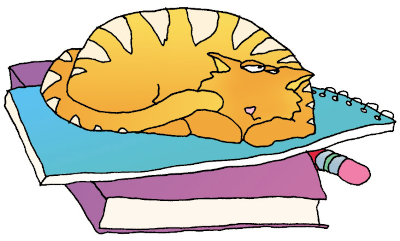 © Thoughtful Learning 2024
© Thoughtful Learning 2024
You can like a poem for what it says (that’s the mind part), and you can like a poem for how it makes you feel (that’s the heart part). It’s the “heart part” that really separates poetry from other forms of writing.
Loud purr, puffball fur,
String dance, parlor prance,
BIIIIIIIIIIIIIIIIIIIIIIG stretch—
That’s what cuddle-cats are made of.
3. Poetry says a lot in a few words.
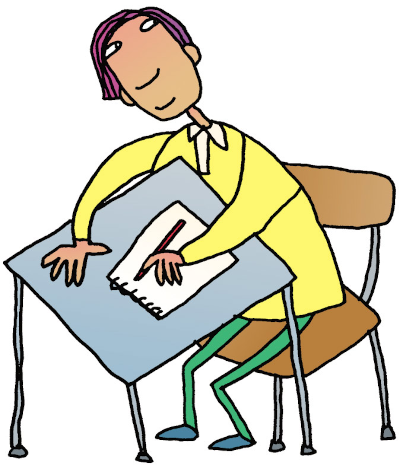 © Thoughtful Learning 2024
© Thoughtful Learning 2024
Poets create word pictures using details about the sights, sounds, smells, tastes, and physical feelings connected with a subject.
Orange leaves and black starlings (sight)
chatter and peep in ragged crowns (sound)
as frigid fingers pluck them loose. (physical feeling)
Leaves cascade in cold flurries. (sight and feeling)
Starlings soar in warm murmurations. (sight, sound, and feeling)

Loud purr, puffball fur,
String dance, parlor prance,
BIIIIIIIIIIIIIIIIIIIIIIG stretch—
That’s what cuddle-cats are made of.
3. Poetry says a lot in a few words.
 © Thoughtful Learning 2024
© Thoughtful Learning 2024
Poets create word pictures using details about the sights, sounds, smells, tastes, and physical feelings connected with a subject.
Orange leaves and black starlings (sight)
chatter and peep in ragged crowns (sound)
as frigid fingers pluck them loose. (physical feeling)
Leaves cascade in cold flurries. (sight and feeling)
Starlings soar in warm murmurations. (sight, sound, and feeling)
String dance, parlor prance,
BIIIIIIIIIIIIIIIIIIIIIIG stretch—
That’s what cuddle-cats are made of.

chatter and peep in ragged crowns (sound)
as frigid fingers pluck them loose. (physical feeling)
Leaves cascade in cold flurries. (sight and feeling)
Starlings soar in warm murmurations. (sight, sound, and feeling)
WE 283
Page 283
4. Poetry says things in special ways.
Poets will sometimes create special word pictures by making comparisons. They may write a metaphor or a simile, like “She wiggled like a puppy.” Can you figure out which things are being compared in the following examples?
Tree Thoughts
Branches trade touches in air
Roots share secrets in earth
Neurons of the forest, thinking
—A. J. White
sunflower seeds, peanuts,
chicken, watermelon—
little tolls I pay for passage
to a crow’s heart
—Josh Jones
sunflower seeds, peanuts,
chicken, watermelon—
little tolls I pay for passage
to a crow’s heart
—Josh Jones
5. Poetry pleases the ear.
Poets carefully arrange words until their poems sound just right. Sometimes they use words that rhyme. Sometimes they repeat certain vowel and consonant sounds to make their poems sound pleasing. Notice how this repetition of sounds works in the poem called “Grandma’s Porch.”
Grandma’s Porch
Sun streams gently through metal mesh
to warm a wicker love seat and chair,
loved too much by cats’ claws.
Words of Walt Whitman climb the walls,
written in grandma’s once-steady hand:
“And your very flesh shall be a great poem . . .”
I listen to her stories, and we laugh,
and I think of how her life has been
a great poem.
—Rhea Lynne
Express Yourself
You will find pleasing sounds, sensory details, similes, and metaphors in regular writing, too. They just stand out more in poetry.
WE 284
Page 284
Writing a Free-Verse Poem
The following guidelines will help you write a free-verse poem. Free-verse poetry does not follow a specific form, or pattern, and it usually does not rhyme.
Prewriting Planning Your Poem
Choose a Subject 🟪 Write your poem about a subject that truly interests you: a special experience, a close friend, a favorite animal, a strong feeling, and so on.
Gather Your Thoughts 🟪 Freewriting about your subject can be a good way to begin. Here, a student freewrites about an important day.
My new town in Indiana had a dog park, so I took my old beagle, Pepper. I was nervous. He didn’t know any of the dogs. I didn’t know anyone since moving from Tucson. At first I sat on the bench and kept Pepper on his leash, but the other dogs were running free. Pepper whined. I let him go. He ran right up to a big shepherd. I wondered if he’d get eaten. “That’s Willard,” said the shepherd’s owner as she sat beside me. “Looks like they’ll be friends. I’m Ainslee, by the way.”
My new town in Indiana had a dog park, so I took my old beagle, Pepper. I was nervous. He didn’t know any of the dogs. I didn’t know anyone since moving from Tucson. At first I sat on the bench and kept Pepper on his leash, but the other dogs were running free. Pepper whined. I let him go. He ran right up to a big shepherd. I wondered if he’d get eaten. “That’s Willard,” said the shepherd’s owner as she sat beside me. “Looks like they’ll be friends. I’m Ainslee, by the way.”
WE 285
Page 285
Writing Developing the First Draft
Create a Poem 🟪 The next step is to turn your freewriting into a poem. Focus on words with the right sound and feeling. Say things in special ways. Think of where to break the lines.
The writer shifts to third person to see herself from the outside. She also uses present tense. A new girl, an old beagle,
at the dog park in a new town.
The girl sits on the bench,
Pepper leashed by her side.
Sentences get shorter to show increasing nervousness. Other dogs run free.
He whines to see them.
“That shepherd will eat you.”
Pepper paws the ground.
The girl unclasps the leash.
Pepper charges the shepherd.
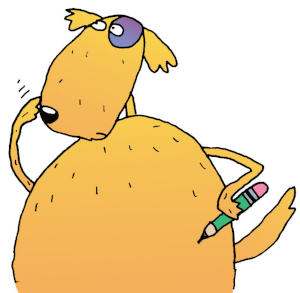
Two-word sentences create suspense. “Oh no!”
They circle.
They sniff.
They bark.
They grin.
The ending hints at a new friendship for the two girls. “Looks like they’ll be friends.”
Another new girl sits on the bench.
“I’m Ainslee, by the way.”
WE 286
Page 286
Revising Improving Your Poem
Now you can turn your basic poem into a very special poem by doing some revising.
Add Word Pictures 🟪 Ask yourself what words you can add to brighten your poem. Try using word pictures like personification, similes, and metaphors. (See “The Sounds of Poetry” on page 289.)
Create a Shape 🟪 Think about writing the words in ways that make them look and sound like the topic of your poem.
Sample Free-Verse Poem
Dog Park Dance
Fragments make the poem halting. New girl. Old beagle.
Dog park in a new town.
On a bench by a fence,
The writer adds a simile. like kids on the wall at a school dance
watching others have fun without them.
Dance becomes a metaphor. Pepper shimmies.
“That shepherd will eat you.”
Pepper does the cha-cha.
The girl lets him go.
Pepper charges the shepherd.

“Oh no!”
The writer indents the lines to make them dance. They samba.
They boogie.
They foxtrot.
They waltz.
“Looks like they’ll be friends.”
She changes the ending for stronger effect. Another new girl sits on the bench.
“I’m Ainslee. Is this your first dance?”
WE 287
Page 287
Revising Different Versions
“Dog Park Dance” is a good example of a free-verse poem. But sometimes poets like to create more regular rhythms and rhymes in their poems. Regular rhythms and rhymes are fun to say aloud. What’s more, they help people remember poems!
Create Rhyme 🟪 Rhyme is important because it gives sound and a musical quality to a poem. Our brains like sounds that are similar but also a bit different—like beat and feet. These sounds are friendly to each other.
Rhyme doesn’t have to be perfect to be interesting. Feet and beat are perfect rhymes because only one sound changes, the first letter. You can also use slant rhyme and internal rhyme.
Perfect rhyme Words at the end of a line that sound exactly alike except for the first letter or letters, like frog and dog, or stutter and butter
Slant rhyme Words that sound similar but are not perfect rhymes, like Pepper and shepherd or bench and fence
Internal rhyme Rhyme that happens inside a line, or before the end of a line: I hear fear in the air
Develop Rhythm 🟪 Rhythm comes from the Greek word rhythmos, meaning “to flow.” In speech, it is the natural rise and fall of the language that creates the rhythm. Some syllables are stressed, or said with more force, than others. If you say the nursery rhyme “Old Mother Hubbard” aloud, you will hear yourself stressing some words more than others. That’s rhythm!
Old mother Hubbard,
went to the cupboard,
to give her poor dog a bone. . . .
Tip You can vary the rhythm by saying some words louder or faster than others. A fast rhythm can suggest excitement, and a slow rhythm can suggest laziness or sleepiness.
WE 288
Page 288
Sample Rhymed Poem
The writer recasts her poem to have regular rhythm and rhyme. She also breaks it into stanzas (groupings of lines). Read the poem aloud. Do you prefer the rhymed poem or the free-verse version?
Dog Park Dance
Lines shift from four stresses to three stresses. New girl. Old beagle.
Dog park in a new town.
On a bench by a fence,
crouched and staring down
like a pair of hungry eagles.
The end rhymes shift throughout the poem. Pepper barks, “I want to meet you!”
The girl begins to grumble,
“Don’t you know that dog’ll eat you?
Oh . . . avoid a rumble!”
She lets him go but shouts, “Oh no!”
She switches out the dances so that they rhyme with "go" and “no.” Dogs tango.
They disco.
They conga.
They do-si-do.
A voice says, “Looks like they’ll be friends.
Hey, my name is Ainslee.”
The new girl sits down near the end.
“Do you think we might be?”
WE 289
Page 289
Editing and Proofreading
Make sure your poem reads well. Do you stumble over certain words or lines in the poem? If so, change them.
Review the form. Does the shape of your poem truly reflect what you are trying to say?
Check for errors. Use the checklist on page 66 as a guide.
Write a final copy of your poem. Make all of the corrections in the final copy and proofread this copy before sharing it.
The Sounds of Poetry
Here are some special writing devices used in poetry.
Alliteration 🟪 The repetition of beginning consonant sounds in words like dance, dare, and drop.
Assonance 🟪 The repetition of vowel sounds in words like rain, makes, pavement, and wavy.
End Rhyme 🟪 The rhyming of words at the ends of two or more lines of poetry.
Metaphor 🟪 A comparison without using the words like or as. The full moon is a shiny balloon.
Onomatopoeia 🟪 The use of words that sound like the noise they name, as in buzz, thump, and snap.
Personification 🟪 A comparison in which something that is not human is described with human qualities. The sunflowers smiled at us.
Repetition 🟪 The repeating of a word or phrase to add rhythm or emphasis. The wind hissed, hissed down the alley.
Rhythm 🟪 The pattern of sounds and beats that helps poetry flow from one idea to the next.
Simile 🟪 A comparison using the words like or as. Granny’s condo looks like a dollhouse.
WE 290
Page 290
Traditional Poetry
Traditional poetry has been around for a long time. Here are some examples:
Ballad 🟪 Ballad poems tell a story. The ballad is written in four-line stanzas. Often the second and fourth lines rhyme. (Here is the first stanza of “Ballad of Skull Rock.”)
We miners long ago did find
the skull rock on the lake.
The silver lay in open veins,
all shining for the take.
Cinquain 🟪 Cinquain (SIN-kane) poems are five lines long with a specific purpose and number of syllables or words for each line. Here is one type of pattern for a syllable cinquain, followed by an example.
Pattern for a Syllable Cinquain
Line 1: Title (2 syllables)
Line 2: Description or example of the title (4 syllables)
Line 3: Action about the title (6 syllables)
Line 4: Feeling about the title (8 syllables)
Line 5: Synonym for the title (2 syllables)
Example of a Syllable Cinquain
Line 1: Seashells
Line 2: Cockles and clams
Line 3: Collecting on beaches
Line 4: Waiting for me to pick them up
Line 5: Treasures
Couplet 🟪 A couplet is a two-line verse form that usually rhymes and expresses one thought.
Back and forth the dancer whirled,
A butterfly with wings unfurled.
Free Verse 🟪 Free verse is poetry that does not include patterned rhyme or rhythm. (See the sample on page 286.)
WE 291
Page 291
Haiku 🟪 Haiku (hi-KU) is a traditional Japanese poem about nature. In English haiku, the first line is five syllables; the second, seven; the third, five.
Sun shines on sidewalks, (5 syllables)
weeds grow sideways in small cracks, (7 syllables)
ants take treasures home. (5 syllables)
Limerick 🟪 A limerick is a funny verse in five lines. Lines one, two, and five rhyme, as do lines three and four. Lines one, two, and five have three stressed syllables; lines three and four have two stressed syllables.
There ONCE was a CHEF named MauRICE
Who ALways used WAY too much GREASE.
His CHICKen was FINE;
His FRIES were diVINE,
But his DINners could MAKE me oBESE.
Lyric 🟪 A lyric is a song-like poem that uses sensory details. Add a tune, and it can become a song.
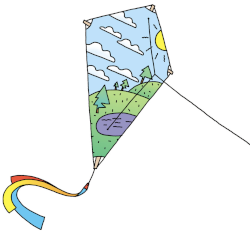
Up! Up! Bright kites fly, oooh,
maroon, and yellow, and easy blue
over the evening park.
I like to think they pull me, too,
up into that blue, that easy blue,
far away from the dark.
Quatrain 🟪 A quatrain is a four-line stanza. In this sample, the first two lines rhyme, and the last two lines rhyme. (In some quatrains, the first and third and the second and fourth lines rhyme.)
The buses in cities are hot
And I have to ride them a lot.
But sometimes I get a good seat
And guess who is happy? My feet!
WE 292
Page 292
Playful Poetry
Poets have fun inventing new forms of poetry. Here are some invented forms to try.
Alphabet Poetry 🟪 An alphabet poem uses a part of the alphabet (such as d, e, f, g) to create a list poem.
Delightful
Evergreen
Forever
Green
Concrete Poetry 🟪 Concrete poetry takes on a special shape that expresses the poem’s meaning or feeling.
The way to school is down
WIDE streets
FULL OF BIG PEOPLE!!!
Definition Poetry 🟪 Definition poetry creatively tells the meaning of a word or an idea.
FRIENDSHIP
Friendship is like the moon and stars,
hanging around together,
walking across the Milky Way.
Five W’s Poetry 🟪 A 5 W’s poem answers Who? What? Where? When? and Why?
I (Who?)
Love to skate (What?)
Along Venice Beach (Where?)
In the middle of the day (When?)
Because people are friendly and get out of my way. (Why?)
WE 293
Page 293
List Poetry 🟪 A list can be a poem. Often the title says what the list is about.
What’s in the box under my bed?
eight marbles and a shoestring
a shiny bubblegum ring
two valuable baseball cards
some chocolate candy bars
a letter my friend wrote . . .
Name Poetry 🟪 A name poem, or acrostic poem, uses the letters of a name or a word to begin each line in the poem.
Friendly
Remarkable
Energetic
Dude
Calm eyes
Outgoing
Open
Laid-back
Telephone-Number Poetry 🟪 You can “find” a poem in your phone number. Each number can represent either syllables or whole words. Let’s say your phone number is 362-4814. The first line of your poem will have three syllables (or words), the second will have six, the third will have two, and so on. Here’s an example:
Our cat starts (3 syllables)
his mornings on my lap (6 syllables)
before (2 syllables)
stalking stuffed mice (4 syllables)
or dashing downstairs to explore. (8 syllables)
He (1 syllable)
likes things the same. (4 syllables)
Terse Verse 🟪 Terse verse is short and humorous—two words that rhyme and have the same number of syllables. The title is the subject.
Joke Books
Smile File
Lemonade
Pink Drink
Candy
Sweet Treat
his mornings on my lap (6 syllables)
before (2 syllables)
stalking stuffed mice (4 syllables)
or dashing downstairs to explore. (8 syllables)
He (1 syllable)
likes things the same. (4 syllables)
Terse Verse 🟪 Terse verse is short and humorous—two words that rhyme and have the same number of syllables. The title is the subject.
Joke Books
Smile File
Lemonade
Pink Drink
Candy
Sweet Treat
Teacher Support:
Click to find out more about this resource.
© 2025 Thoughtful Learning. Copying is permitted.
k12.thoughtfullearning.com